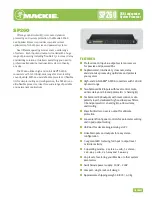36-Mbit QDR™-II SRAM 4-Word
Burst Architecture
CY7C1411JV18, CY7C1426JV18
CY7C1413JV18, CY7C1415JV18
Cypress Semiconductor Corporation
•
198 Champion Court
•
San Jose
,
CA 95134-1709
•
408-943-2600
Document Number: 001-12557 Rev. *C
Revised June 25, 2008
Features
■
Separate independent read and write data ports
❐
Supports concurrent transactions
■
300 MHz clock for high bandwidth
■
4-word burst for reducing address bus frequency
■
Double Data Rate (DDR) interfaces on both read and write ports
(data transferred at 600 MHz) at 300 MHz
■
Two input clocks (K and K) for precise DDR timing
❐
SRAM uses rising edges only
■
Two input clocks for output data (C and C) to minimize clock
skew and flight time mismatches
■
Echo clocks (CQ and CQ) simplify data capture in high speed
systems
■
Single multiplexed address input bus latches address inputs
for both read and write ports
■
Separate port selects for depth expansion
■
Synchronous internally self-timed writes
■
QDR-II operates with 1.5 cycle read latency when DLL is
enabled
■
Operates similar to a QDR-I device with 1 cycle read latency
in DLL off mode
■
Available in x 8, x 9, x 18, and x 36 configurations
■
Full data coherency, providing most current data
■
Core V
DD
= 1.8 (±0.1V); IO V
DDQ
= 1.4V to V
DD
■
Available in 165-ball FBGA package (15 x 17 x 1.4 mm)
■
Offered in both Pb-free and non Pb-free packages
■
Variable drive HSTL output buffers
■
JTAG 1149.1 compatible test access port
■
Delay Lock Loop (DLL) for accurate data placement
Configurations
CY7C1411JV18 – 4M x 8
CY7C1426JV18 – 4M x 9
CY7C1413JV18 – 2M x 18
CY7C1415JV18 – 1M x 36
Functional Description
The CY7C1411JV18, CY7C1426JV18, CY7C1413JV18, and
CY7C1415JV18 are 1.8V Synchronous Pipelined SRAMs,
equipped with QDR™-II architecture. QDR-II architecture
consists of two separate ports to access the memory array. The
read port has dedicated data outputs to support the read opera-
tions and the write port has dedicated data inputs to support the
write operations. QDR-II architecture has separate data inputs
and data outputs to completely eliminate the need to “turn
around” the data bus required with common IO devices. Access
to each port is through a common address bus. Addresses for
read and write addresses are latched on alternate rising edges
of the input (K) clock. Accesses to the QDR-II read and write
ports are completely independent of one another. To maximize
data throughput, read and write ports are equipped with DDR
interfaces. Each address location is associated with four 8-bit
words (CY7C1411JV18), 9-bit words (CY7C1426JV18), 18-bit
words (CY7C1413JV18), or 36-bit words (CY7C1415JV18) that
burst sequentially into or out of the device. Because data can be
transferred into and out of the device on every rising edge of both
input clocks (K and K and C and C), memory bandwidth is
maximized while simplifying system design by eliminating bus
“turn arounds”.
Depth expansion is accomplished with port selects, which
enables each port to operate independently.
All synchronous inputs pass through input registers controlled by
the K or K input clocks. All data outputs pass through output
registers controlled by the C or C (or K or K in a single clock
domain) input clocks. Writes are conducted with on chip
synchronous self-timed write circuitry.
Selection Guide
300 MHz
250 MHz
200 MHz
Unit
Maximum Operating Frequency
300
250
200
MHz
Maximum Operating Current
x8
965
745
620
mA
x9
970
760
620
x18
1010
790
655
x36
1130
870
715
[+] Feedback


















